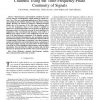Free Online Productivity Tools
i2Speak
i2Symbol
i2OCR
iTex2Img
iWeb2Print
iWeb2Shot
i2Type
iPdf2Split
iPdf2Merge
i2Bopomofo
i2Arabic
i2Style
i2Image
i2PDF
iLatex2Rtf
Sci2ools
TSP
2010
2010
Localization in underwater dispersive channels using the time-frequency-phase continuity of signals
Time-frequency representations constitute the main tool for analysis of nonstationary signals arising in real-life systems. One of the most challenging applications of time-frequency representations deal with the analysis of the underwater acoustic signals. Recently, the interest for dispersive channels increased mainly due to the presence of the wide band nonlinear effect at very low frequencies. That is, if we intend to establish an underwater communication link at low frequencies, the dispersion phenomenon has to be taken into account. In such conditions, the application of the conventional time-frequency tools could be a difficult task, mainly because of the nonlinearity and the closeness of the time-frequency components of the impulse response. Moreover, the channel being unknown, any assumption about the instantaneous frequency laws characterizing the channel could not be approximate. In this paper, we introduce a new time-frequency analysis tool that aims to extract the time-fre...
Artificial Intelligence | Low Frequencies | Time-frequency Components | Time-frequency Representations | TSP 2010 |
| Added | 22 May 2011 |
| Updated | 22 May 2011 |
| Type | Journal |
| Year | 2010 |
| Where | TSP |
| Authors | Cornel Ioana, Arnaud Jarrot, Cedric Gervaise, Yann Stéphan, André Quinquis |
Comments (0)

